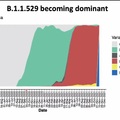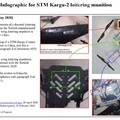A while ago I started an open-ended Twitter thread on Russia's use of various military vehicles converted into Vehicle-Based Improvised Explosive Devices (VBIEDs); this is a link to that thread for those who are able to view it. So far, there are four video-recorded observations of such attacks, on top of which at least one more incident was reliably reported already back in the spring around Kreminna (overall, there have certainly been more than five incidents of this kind, per reports of varying accuracy). The attacks in question used up at least two tanks (one T-54/55 (?) and one T-62) and three MT-LB armoured fighting vehicles.
The tactic involves having a skeleton crew man the vehicle packed full of explosives (such as, FAB-500 bombs, anti-tank mines or UR-77 mine-clearing charges) to steer it and thus launch it towards Ukrainian positions, that is, typically, trenches and foxholes in a tree line framing a field (mostly the remnants of what used to be a tree line once, before WWI-level artillery coverage reshaped the landscape). The crew then "disembark" (jump) — it is a risky but not a suicidal move by intent. The vehicle itself, now unmanned, has to cover a considerable distance to close in on its target, without precision, by and large headed towards the spot that the crew originally aimed for, from which a number of things could cause it to divert.
In the process, it may be struck by ATGMs (anti-tank guided missiles), a lucky artillery shot may immobilise it to have it be finished off by FPV drones or drone-dropped munitions, or it may drive onto mines. It may simply get stuck due to running into an obstacle, too.
When it gets close enough to its target, some damage to the target is inevitable. Once triggered, the resulting huge blast from the explosion can clear mines in a large area in front of the Ukrainian positions attacked, as well as remove some of the remaining cover over and around those positions, undermining their defenses. It is definitely not healthy for anyone to be in the blast radius, even with cover; the shockwave is quite something to withstand in any case; debris may fall on you; recocheting shrapnel can cause wounds; one may even be buried completely under mud and dirt, etc.
Knowing it is necessary to avoid this, the positions may need to be pre-emptively abandoned, at least temporarily, provided the soldiers in those positions are aware of what is coming. To take out the approaching VBIED, firing positions have to be revealed, handing useful coordinates via an enemy drone in overwatch to the enemy's artillery.
Having said that, the tactic is not guaranteed to cause major damage, and is thus a questionable use of a lot of explosives and heavy pieces of equipment such as tanks and AFVs. For a force defending, as Russian forces currently are along major sections of the "zero line," faced with the Ukrainian counter-offensive, it should in principle be especially questionable to use this tactic, as they do not have the momentum to capitalise on temporarily breaching the integrity of the enemy lines.
So why do they do this? Do they trust that their reserves will be endlessly replenished, whatever it costs? Are these attacks initiated by local commanders, with their own incentives? Because they are trying to mount a local counter-attack? Or because they think they would lose these vehicles anyway and are trying to make the most of their use? I know of at least one instance where a local counter-attack involved the use of the tactic, supporting an actual attempt to advance. The seemingly increasing use of this tactic also suggests involvement beyond local commanders acting on local initiative (of which there is generally very little permitted in the Russian armed forces). Overall, I am not sure there is a single coherent logic behind the instances where this tactic occurs. In any case, this is noteworthy. With a lot of old T-54 tanks headed towards the frontline, to be deployed by Russia, it seems safe to expect further increased use of this tactic. Those tanks are not good for much else beyond an indirect fire role and whatever else that's creative use that one can think of.
One thing there certainly is to be warned of. Many are ridiculing these tactics, typically framing them as "primitive ISIS tactics." Unfortunately, ISIS used such tactics with some effect. Those ridiculing these tactics are not there to risk their own lives in countering them. I have seen footage of one incident where a Ukrainian soldier used an RPG (rocket-propelled grenade) to take out a charging VBIED stuck in front of their position from relatively short range — definitely no life insurance (the soldier may have been unaware that this was a VBIED). Russian forces are not in a good shape overall, no doubt, and they are throwing most of their reserves in the way of a so-far cautiously advancing counter-offensive. But to all those focused on ridiculing the tactics in question it is advised to fully take into account the costs that they impose. Costs that an only partially supported Ukrainian force, lacking uninhibited use of air assets and abundant armour, cannot limitlessly tolerate.





